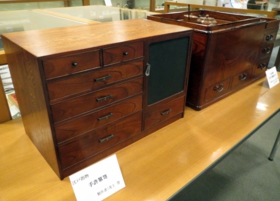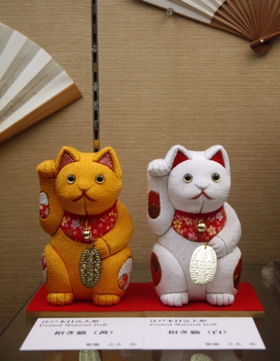Q: The Edo Shitamachi Traditional Crafts Museum is located at the rear of Senso-ji Temple in Asakusa, which is a little bit distant from the station. What about the location from a viewpoint of tourism?
I am not sure about tourism. The density of tourist spots in Taito City is higher than other cities in Japan. However, compared to other foreign cities, such as Paris and London, the number of visitors to Taito City from overseas is small. Paris has the largest number of foreign visitors, and Japan is about 19th. I once participated in a promotional tour that attempted to attract tourists to Tokyo. We went to various countries and cities, and introduced Tokyo. We visited London, Los Angeles and Australia. It was very interesting. Although there are many state-of-the-art products, such as computer and electrical products, in Japan, only thing that Japan has but other countries do not is the art of traditional crafts. I think the art of traditional crafts can be boasted to the world, and it only exists in Japan.
Q: In Sweden and Finland, traditional woodcraft has been handed down to the next generation, and new woodcraft is also created. They are trying to promote themselves as design-oriented countries based on the art of woodcraft. Is it difficult for Japan to promote itself as a craft-oriented country? Has the number of craftsmen decreased?
Japan is not skillful at promoting itself. Japanese cutting instruments are the best in the world. For example, in the Henkel company, the best products are sold by Henkel Japan. Products made by Henkel Japan are selected as the best Henkel products. However, lines of business have decreased. Japanese lifestyle has become Westernized, so the demand for traditional crafts is depressed. Therefore, the form of traditional crafts has gradually changed. If it has not changed, craftsmen cannot make their livings.
Q: Could you tell me about the certified traditional craftsman system established by Tokyo?
I proposed this system. I am the first certified traditional craftsman. Some very old traditional craftsmen have received awards, such as an Order of Cultural Merit. I think, when craftsmen are in their prime, their best work is done. Therefore, I proposed the system to Tokyo, in which people aged about 45-60 are endorsed as certified traditional craftsmen.
I am occasionally asked to repair old crafts. Some of them were created with superb skills. I cannot discern how old those crafts are, but I am deeply impressed by the skills, and admire the ancient craftsmen. We also should not be conceited as craftsmen. I hope that the certified traditional craftsman system will be helpful as part of the effort to be better craftsmen. In the past, there were many people who suggested something to craftsmen. There were so-called "connoisseurs." Nowadays, craftsmen are called "Sensei," or master, even though they have worked for a short period of time, and they will be spoiled. In the past, there were people who gave hints on how to develop traditional crafts and encouraged craftsmen.(continued in the right column)
Q: What kind of activities have you done in order to pass down skills to the next generation?
Many students have visited us on their school trips. If they make crafts by themselves, they become attached to the crafts. Bamboo strings are stocked in my studio, so it is possible to make crafts like a place mat by weaving the strings.
Some studios have offered workshops, which are similar to part-time schools. A part-time school is not a night school. A part-time school offers morning, daytime and evening classes. Students can take morning, daytime, or evening classes. Many working adults also take those classes. We have taught students from noon to 9 p.m. on certain days. Now, we have taught 4 students. They do not take a rest when we say, "Let's have a break." They get down to work soon. When I asked them why they do not take a rest, they answered, "Because it is interesting." Many students say that they do not take a rest because it is interesting, and that they wish they could be also interested in studies. The best thing is to have an interest in it. Some school teachers come to look at traditional crafts, and become captivated by the crafts when they are intrigued by them. Some teachers say they want to quit their jobs and become craftsmen, but they give up doing so.
We had also have workshops at Tokyo University of the Arts. It was a wonderful experience in which we could know young people's ideas that we could never think of. When we exhibited the students' works at a lifelong learning center in Taito city, some visitors said that they wanted to buy the works. I hope that young people carry on those traditions, but it is fairly difficult to make livings by making traditional crafts. Many gold plate and silverware craftsmen have lived in the Yanaka area where Tokyo University of the Arts is located and the Shitaya area. The reason is that craftsmen who make files have also lived in Taito City. If tools disappear, skills also disappear.
Q: What kind of studio and craftsman have existed in Taito City? How are things now?
Once Suiho Tagawa, a painter, lived in Taito City. He was born in a family of a woodblock print publisher called "Takamizawa." His father, a publisher, commissioned painters to draw pictures, woodblock engravers to engrave woodblocks and woodblock printers to print woodblock prints, and sold those prints. So, Suiho Tagawa liked to draw cartoons in his childhood. There is also a shop of Isetatsu in Yanaka, which was a woodblock print publisher in the past. Figured paper is also a type of block prints, so it is very popular abroad. People overseas also have an eye for figured paper. They turn the paper over, and touch it again. Their power of observation is actually superior than Japanese.










